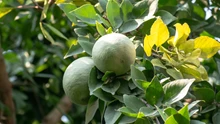
Famous for cultivating cool-season vegetables and fruits in Kerala, Kanthalloor has expanded its agricultural pursuits by successfully growing the Pepino Melon (Solanum muricatum), commonly referred to as sweet cucumber. This exciting addition to the region's crops was discovered by Forest Department officials during a recent visit to a tribal settlement in Nellippettykudi, part of the Marayur Sandal division.
During a tribal produce market auction, Marayur Sandal Divisional Forest Officer (DFO) M.G. Vinod Kumar observed a new crop that received minimal attention and lacked demand. Recognizing the potential, the Forest Department purchased the produce and transported it to the 'Ila' provisions store under its management. Upon learning about the new crop, Mr. Kumar identified it as Pepino Melon, a commercially viable fruit from Peru in South America. Realizing its market potential, he guided local farmers and decided to continue farming the crop. Let’s discuss about this foreign fruit in detail:
Origin and Distribution
Pepinos are indigenous to the Andes of Peru, Colombia, and Ecuador. The history of this variety is a mystery because it's soft and breaks down easily, leaving few traces for scientists to study. It is an annual shrub native to the Andean region of South America and belonging to the Solanaceae family.
It goes by several names such as melon pear, sweet Pepino, Pepino duke, king kiwi, toma, tree Pepino, and mellow fruit. Its cultivation traces back to pre-1889 in San Diego and Santa Barbara in the United States. Commercially viable cultivars were later introduced from New Zealand and elsewhere by the end of the 20th century.
The fruit finds its habitat in countries like Chile, Australia, New Zealand, Morocco, Spain, Israel, and the highlands of Kenya. Introduced to India in 1994 at the Horticultural Research Station, Ooty, it found its way to the Shimla hills in 2004, flourishing across the mid-Himalayan region.
Pepino Melon: General Description
Pepino plants, typically annual but sometimes behaving like biennials or perennials, are erect, spineless, mini-shrubs, reaching heights of up to 90 cm (or up to 150 cm when stalked). They branch profusely, with glabrous branches possessing rough, warty excrescences. The leaves are lanceolate, tri-pentafoliate, dark green, with an acute apex, and finely pubescent or silky.
Pepino Melon Varieties
While there are only a few recognized varieties of pepino melon, two favorites include:
-
Sugar Gold: Characterized by golden hues and overhanging growth up to one meter, ideal for hanging baskets. These pear-sized fruits are sweet and fruity.
-
Copa: A late-ripening variety, growing up to one meter, with fruits ripening from September to October.
Nutritional Value: What is Pepino Melon Good For?
Pepino is celebrated globally for its nutritional benefits. Rich in dietary fiber for healthy digestion and antioxidants like Vitamin C, it also promotes skin health. The fruits are highly juicy, with a moderate sweetness and a pleasing aroma akin to melon fruit. They can be consumed raw as dessert fruits, in salads, or used for juice and squash preparation. Additionally, fully ripe fruits offer a cucumber-like flavor suitable for cooking. With high Vitamin C content (40-60 mg/100 g), pepino also boasts medicinal properties.
Pepino Cultivation Guide
-
Pepino, a tropical fruit, thrives in the low and mid-hills of the Himalayan region, ideally at elevations ranging from 500 to 1800 meters. It prefers a mean temperature between 15 to 25°C and well-drained sandy loam to loam soil with a pH of 6-7. Cultivating pepino starts with propagation, which is typically done through 5-6 cm long softwood stem cuttings during the rainy season.
-
These cuttings are placed in a rooting medium consisting of a mix of soil, sand, and farmyard manure in equal parts to promote good root development. After about fifteen to twenty days, the young plants are ready to be transplanted into the main field, with recommended spacing of 1x1 meters.
-
To ensure high-quality fruit production, it's essential to provide adequate nutrients to the plants. This includes applying well-rotted compost manure at a rate of 10 tonnes per hectare, along with 60 kg of nitrogen, 40 kg of phosphorus, and 40 kg of potassium.
-
Maintaining soil moisture is crucial, especially during the flowering stage, as water stress can lead to flower drop and stunted plant growth. Therefore, regular irrigation, about 2-3 times a week during the summer months, is necessary for healthy plant development.
-
While pepino plants are typically self-pollinated, insect pollination can enhance fruit set. Flowering occurs throughout the year, but fruit set during winter may result in smaller-sized fruits. Extreme temperatures, both high and low, can affect fruit development, with high temperatures causing flower bud shriveling and pollen viability loss.
-
While pepino plants are generally disease-resistant, infestations of thrips have been observed in some areas, notably Shimla. Control measures involve the use of metasystox at a concentration of 0.2%.
-
The time from flowering to fruit ripening typically ranges from 150 to 160 days during the spring-summer season. However, cooler weather conditions may prolong this period. Fruits are ready for harvest when their color changes from pale green to yellowish-green, with purple stripes on the surface.
-
Each pepino plant can yield between 10 to 15 fruits, weighing anywhere from 150 to 700 grams. Due to irregular fruit maturation, multiple pickings may be necessary. When harvesting, it's advisable to pluck the fruits along with the pedicel for better market presentation. These fruits can be stored for 15-20 days under ambient conditions before being sold in the market.
Selecting the Ideal Location for Pepino Melon
Pepino melon, a warm-weather crop, thrives in tropical and sub-tropical climates with temperatures between 10-35°C, preferably 18-25°C. It requires at least 6 hours of sunlight daily, protection from strong winds and frost, and well-drained, fertile, slightly acidic soil (pH 5.5-5.6).
How to Propagate and Care for Pepino Melon Plants
Propagation can be achieved through seeds or cuttings. Seeds should be sown early, from February, in compost on a warm windowsill before transplanting in mid-May. Alternatively, cuttings can be rooted in water or growing soil enriched with sand during early summer.
To care for pepino plants, ensure adequate watering and nutrient supply. Liquid fertilizers like Plantura Liquid Tomato Food can be added to water for simultaneous watering and fertilization. The plant typically does not require thinning and may need support if overhanging in one direction.











